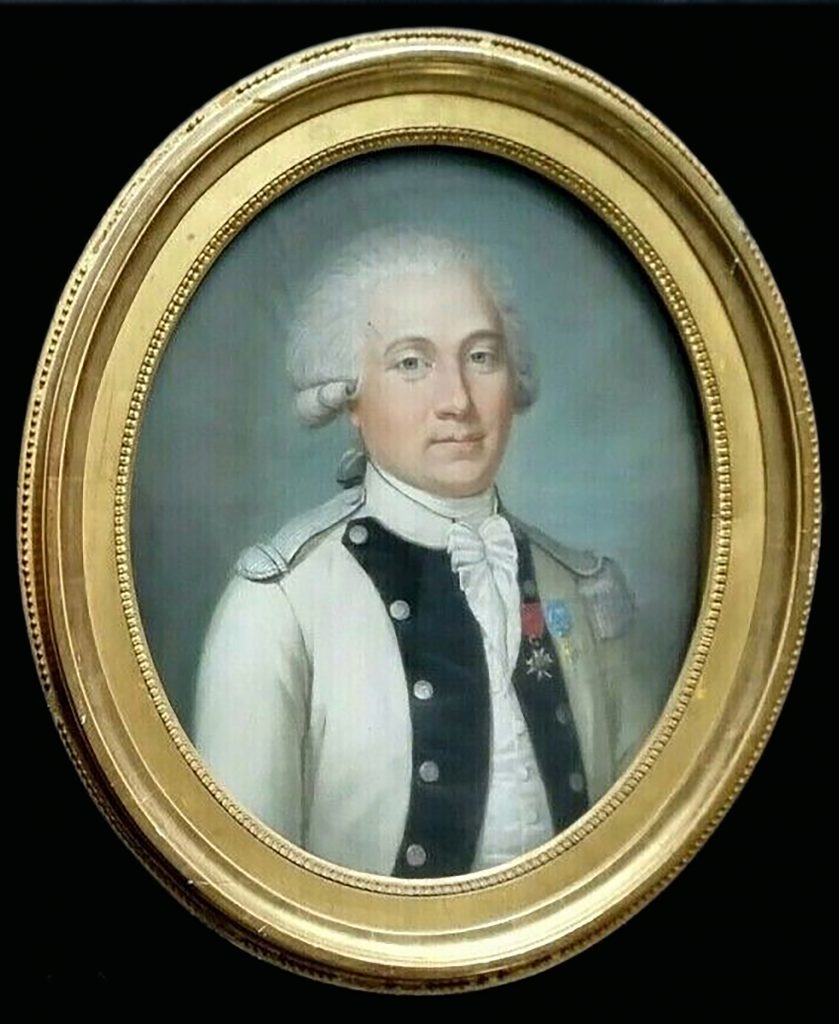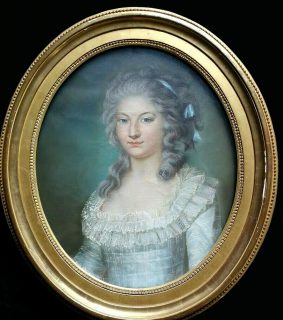
The pastel portrait of Philippe-Jacques-François Aupépin de Lamothe, an officer in the French army during the Revolutionary War, was painted by Charles Thévenin in 1786.
Portraits of soldiers who fought the Revolutionary War—especially ones that show them in uniform—are among the most sought-after objects for the Institute’s museum collections. In March 2021 we added to the portrait collection with a pastel painting of Philippe-Jacques-François Aupépin de Lamothe, an officer in the Auxerrois Regiment of the French army. Having resided in private collections in France until it was recently discovered and acquired, the portrait and the story of Aupépin de Lamothe’s life are now more widely accessible.
Born at Château de Dreuzy in the department of Nièvre in the Burgundy region of France, Philippe-Jacques-François Aupépin de Lamothe (1752-1818) joined the French military in 1763 as an ensign in the Marine Regiment. He served in the French conquest of Corsica in 1767-1768 and started rising in the ranks before the American Revolution. When the Auxerrois Regiment was formed in 1776, Aupépin de Lamothe was transferred to the infantry unit and promoted to lieutenant. The following year he sailed for the West Indies, where he would participate in nearly a dozen engagements as the British and French empires fought over their valuable sugar islands.
Aupépin de Lamothe was wounded during the first two battles in which he fought: the French capture of Dominica in September 1778 and their defeat at St. Lucia three months later. The Auxerrois Regiment sailed with Admiral d’Estaing’s squadron in 1779, when Aupépin de Lamothe fought in the French victory at Grenada as well as the unsuccessful joint French-American siege of Savannah. Returning to the Caribbean, he participated in the Battle of Martinique and two other naval engagements with Admiral Guichen’s squadron in 1780—the year he was promoted to captain—and in the French capture of Tobago in the early summer of 1781. For his conduct in the capture of St. Eustatius in late 1781, Aupépin de Lamothe received the cross of the Order of Saint Louis, a royal award for exceptional and long-serving Catholic officers in the French military. Aupépin de Lamothe’s last battle in America came in early 1782, when he participated in the successful Siege of Brimstone Hill on St. Kitts. The Auxerrois Regiment arrived back in France in July 1783 after six years at war.

The Institute acquired the portrait of Captain Aupépin de Lamothe’s wife, Anne-Marie, as part of the pair.
In 1784 Aupépin de Lamothe returned to his native Nièvre and married Anne-Marie Petit de Vaujetin (d. 1816), whose portrait was acquired as part of a pair with her husband’s. He joined the French branch of the Society of the Cincinnati, whose members treasured their association with George Washington, the organization’s president general, and the part they played in Britain’s defeat in America. Aupépin de Lamothe continued to serve in the French army, being transferred to the Viennois Regiment as a major in 1788 and promoted to his final rank of colonel in 1792. He resigned the next year as the French Revolution became more radical. He later served as mayor of Varzy before his death in 1818. He and his wife had two surviving children, who inherited the portraits and whose descendants preserved them into the twentieth century.
Aupépin de Lamothe commissioned the portraits of himself and his wife from artist Charles Thévenin, who completed the pastels in 1786. The portrait of Aupépin de Lamothe depicts him in the uniform of a captain-commandant in the Auxerrois Regiment, as he appeared at the end of his service in America. The white coat with dark blue facings has silver-toned buttons each bearing the number “12” as the Auxerrois was designated the twelfth regiment of the French army. The full epaulet on his left shoulder and contra epaulet, without fringe, on his right shoulder indicate the rank of captain-commandant. A captain-commandant, or first captain, was the commanding officer of a troop or company of the regiment. The cross of the Saint Louis and the Society of the Cincinnati Eagle—symbols of his service in America—hang prominently on his coat.
Read about the conservation of these pastels.
Learn more about French officers’ experience in the American war in our exhibition Revolutionary Reflections: French Memories of the War for America.
Watch a lecture on the American Revolution in the Caribbean by Andrew O’Shaughnessy, Saunders Director of the Robert H. Smith International Center for Jefferson Studies at the Thomas Jefferson Foundation.
View More Paintings in the Institute's Collections